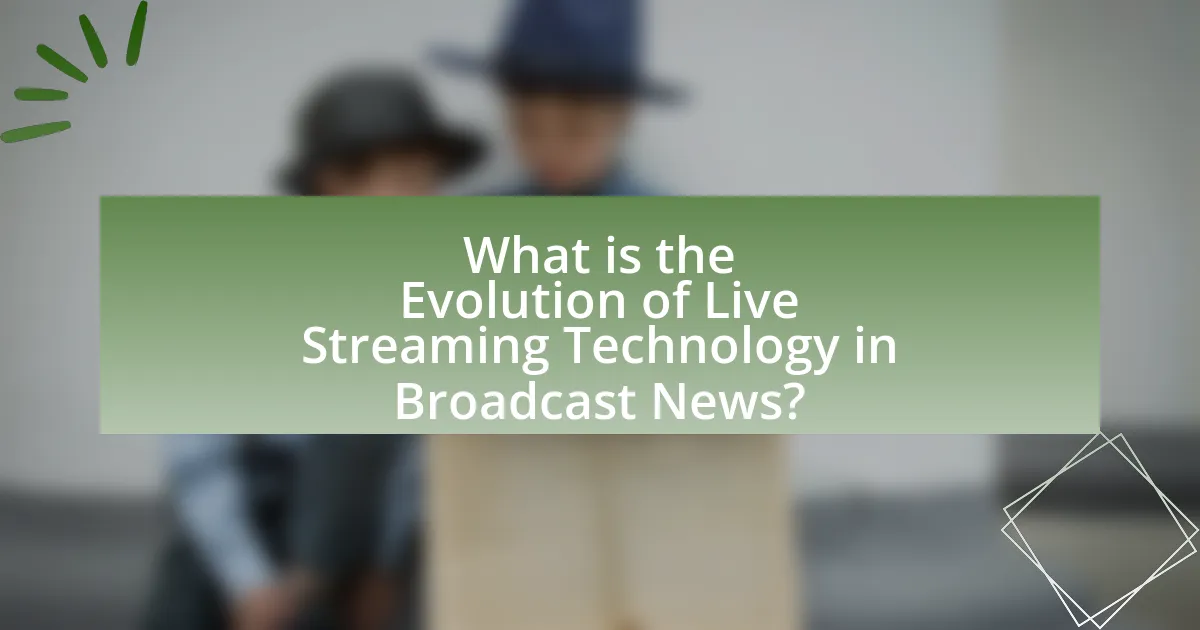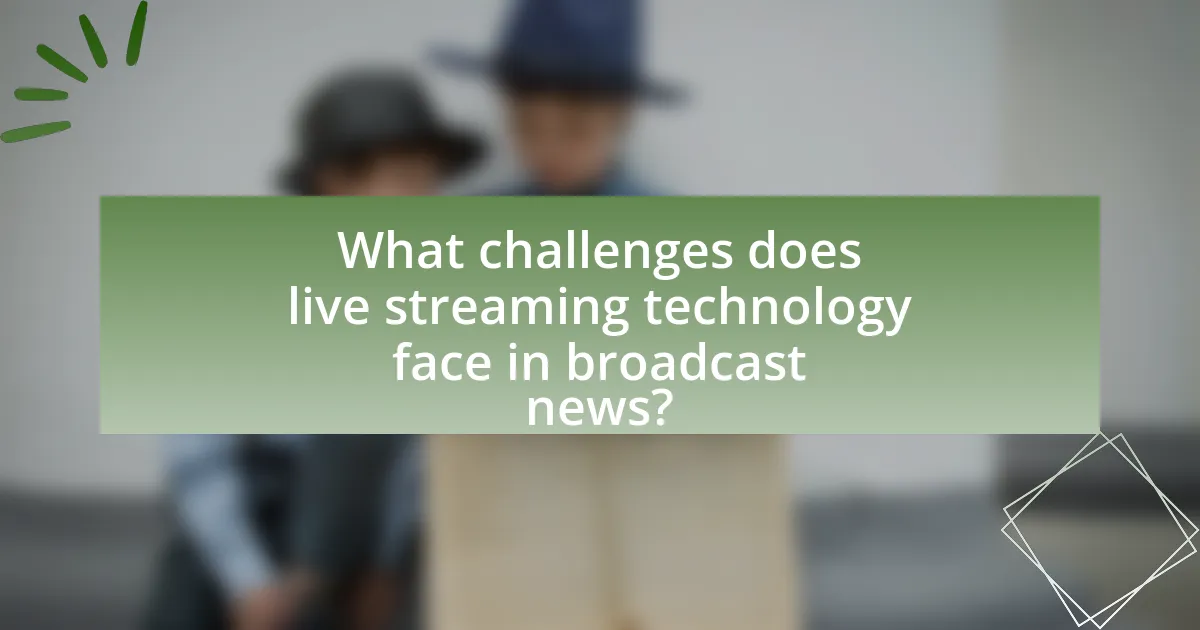The article examines the evolution of live streaming technology in broadcast news, highlighting its transformative impact on news delivery and consumption. It traces the progression from traditional satellite and cable broadcasting to the advent of internet-based streaming protocols, mobile technology, and social media platforms, which have democratized access to live news. Key advancements, such as cloud computing and 5G networks, have further enhanced the quality and immediacy of live reporting. The article also addresses the challenges and ethical considerations associated with live streaming, as well as best practices for news organizations to engage audiences effectively.

What is the Evolution of Live Streaming Technology in Broadcast News?
The evolution of live streaming technology in broadcast news has transformed how news is delivered and consumed. Initially, live broadcasting relied on satellite and cable technologies, which were expensive and limited in accessibility. The introduction of the internet in the late 1990s allowed for the development of streaming protocols like Real-Time Streaming Protocol (RTSP) and later, HTTP Live Streaming (HLS), which enabled more efficient transmission of video content over the web.
By the mid-2000s, platforms such as YouTube and Ustream emerged, democratizing live streaming and allowing news organizations to reach wider audiences without the need for traditional broadcasting infrastructure. The rise of mobile technology further accelerated this trend, as smartphones equipped with high-quality cameras and internet connectivity enabled journalists to report live from virtually anywhere.
In recent years, advancements in cloud computing and content delivery networks (CDNs) have improved the reliability and scalability of live streaming. Technologies like 5G networks are now enhancing the quality and speed of live broadcasts, allowing for real-time reporting with minimal latency. According to a report by Cisco, video traffic will account for 82% of all consumer internet traffic by 2022, underscoring the growing importance of live streaming in news dissemination.
Overall, the evolution of live streaming technology in broadcast news reflects a shift towards more immediate, accessible, and interactive news delivery methods, fundamentally changing how audiences engage with news content.
How has live streaming technology transformed broadcast news?
Live streaming technology has transformed broadcast news by enabling real-time reporting and audience engagement. This technology allows news organizations to broadcast events as they happen, providing immediate access to information and enhancing the viewer experience. For instance, during significant events like protests or natural disasters, live streaming has become essential for delivering timely updates, as seen in the coverage of the 2020 Black Lives Matter protests, where platforms like Facebook Live and Twitter were utilized extensively. Furthermore, live streaming facilitates direct interaction between news outlets and their audiences through comments and social media shares, fostering a more participatory news environment. This shift has led to increased viewer loyalty and a broader reach, as audiences can access news content on various devices anytime and anywhere.
What were the early forms of live streaming in news broadcasting?
The early forms of live streaming in news broadcasting included satellite transmission and microwave relay systems. Satellite transmission, which became prominent in the 1970s, allowed news organizations to broadcast live events from remote locations directly to viewers, significantly enhancing the immediacy of news coverage. Microwave relay systems, used since the 1950s, enabled live broadcasts by transmitting signals over line-of-sight paths, facilitating real-time reporting from various locations. These technologies laid the groundwork for modern live streaming by establishing the capability for instantaneous news dissemination.
How did technological advancements influence live streaming capabilities?
Technological advancements significantly enhanced live streaming capabilities by improving bandwidth, compression algorithms, and streaming protocols. The introduction of high-speed internet, such as fiber optics, allowed for higher quality video transmission with minimal latency. Additionally, advancements in video compression technologies, like H.264 and HEVC, enabled efficient data transmission, reducing the bandwidth required for high-definition streaming. Furthermore, the development of protocols such as RTMP (Real-Time Messaging Protocol) and HLS (HTTP Live Streaming) facilitated smoother and more reliable streaming experiences. These innovations collectively transformed live streaming into a viable option for broadcast news, allowing real-time coverage and broader audience reach.
Why is live streaming important for modern broadcast news?
Live streaming is important for modern broadcast news because it enables real-time reporting and audience engagement. This immediacy allows news organizations to deliver breaking news as it happens, fostering a sense of urgency and relevance. According to a 2021 report by the Pew Research Center, 53% of U.S. adults say they often get news from social media, where live streaming is a prevalent format, highlighting its role in contemporary news consumption. Furthermore, live streaming enhances viewer interaction through comments and shares, creating a more dynamic news experience.
What advantages does live streaming provide over traditional broadcasting?
Live streaming offers several advantages over traditional broadcasting, primarily including real-time interaction, accessibility, and cost-effectiveness. Real-time interaction allows viewers to engage with content through comments and live chats, fostering a sense of community and immediacy that traditional broadcasting lacks. Accessibility is enhanced as live streaming can be accessed on various devices, including smartphones and tablets, reaching a broader audience without geographical limitations. Additionally, live streaming typically incurs lower production and distribution costs compared to traditional broadcasting, which often requires expensive equipment and infrastructure. These factors contribute to the growing preference for live streaming in the broadcast news landscape.
How does live streaming enhance viewer engagement and interaction?
Live streaming enhances viewer engagement and interaction by providing real-time communication and immediate feedback opportunities. This format allows viewers to participate actively through comments, questions, and reactions during the broadcast, fostering a sense of community and connection. According to a study by the Interactive Advertising Bureau, 63% of viewers feel more connected to brands that engage with them through live streaming, highlighting the effectiveness of this medium in creating interactive experiences. Additionally, platforms like Facebook Live and YouTube Live report higher viewer retention rates compared to pre-recorded content, further demonstrating that live streaming captivates audiences by making them feel involved and valued in the conversation.

What are the key milestones in the evolution of live streaming technology?
The key milestones in the evolution of live streaming technology include the introduction of Real-Time Streaming Protocol (RTSP) in 1998, which enabled the streaming of audio and video over the internet. In 2005, the launch of YouTube revolutionized user-generated content and live streaming capabilities. The development of Adobe Flash Media Server in 2002 allowed for more robust streaming options, while the introduction of HTML5 in 2010 facilitated browser-based streaming without the need for plugins. In 2015, Facebook Live and Periscope popularized live streaming on social media platforms, significantly increasing accessibility and audience engagement. These milestones collectively transformed live streaming into a mainstream medium for broadcasting news and events.
What technological innovations have shaped live streaming in news?
Technological innovations that have shaped live streaming in news include advancements in mobile broadcasting, cloud computing, and high-speed internet connectivity. Mobile broadcasting technology, such as LiveU and Teradek, allows journalists to transmit live video from remote locations using cellular networks, enhancing coverage of breaking news events. Cloud computing enables news organizations to store and process large volumes of video data efficiently, facilitating real-time editing and distribution. Additionally, the proliferation of 5G networks has significantly improved streaming quality and reduced latency, allowing for seamless live broadcasts. These innovations collectively enhance the immediacy and accessibility of news coverage, reflecting the evolving landscape of broadcast journalism.
How did the introduction of the internet impact live streaming?
The introduction of the internet revolutionized live streaming by enabling real-time broadcasting to a global audience. Prior to the internet, live streaming was limited to traditional broadcasting methods, which restricted accessibility and interactivity. With the advent of high-speed internet in the late 1990s and early 2000s, platforms like YouTube and Twitch emerged, allowing users to stream content live without the need for expensive broadcasting equipment. This shift facilitated the rise of user-generated content and democratized media production, as anyone with an internet connection could share live events. According to a report by Cisco, video traffic accounted for 82% of all consumer internet traffic by 2022, underscoring the significant impact of the internet on the prevalence and consumption of live streaming.
What role did mobile technology play in the evolution of live streaming?
Mobile technology significantly advanced the evolution of live streaming by enabling real-time broadcasting from virtually anywhere. The proliferation of smartphones equipped with high-quality cameras and internet connectivity allowed users to stream live events seamlessly, democratizing content creation and distribution. For instance, platforms like Facebook Live and Instagram Live leveraged mobile technology to facilitate instant broadcasting, leading to a surge in user-generated content. According to a report by Statista, as of 2021, over 80% of internet users accessed live streaming services via mobile devices, highlighting the critical role mobile technology plays in shaping viewer engagement and accessibility in live streaming.
What are the major platforms for live streaming in broadcast news?
The major platforms for live streaming in broadcast news include YouTube Live, Facebook Live, Twitter (now X) Live, and Twitch. These platforms enable news organizations to reach audiences in real-time, facilitating immediate dissemination of information. For instance, YouTube Live allows broadcasters to stream events directly to millions of viewers, while Facebook Live integrates social interaction, enhancing viewer engagement. According to a 2021 report by the Pew Research Center, 73% of U.S. adults use YouTube, making it a critical platform for news dissemination.
Which platforms have emerged as leaders in live streaming news content?
YouTube, Facebook Live, and Twitter have emerged as leaders in live streaming news content. YouTube has established itself as a dominant platform due to its vast user base and integration of live streaming features, allowing news organizations to reach millions instantly. Facebook Live has gained traction for its interactive capabilities, enabling real-time audience engagement, which is crucial for news dissemination. Twitter, particularly through its Periscope feature, has been pivotal for breaking news, allowing users to share live updates and engage with trending topics. These platforms collectively account for a significant share of live streaming news content, driven by their user engagement and accessibility.
How do these platforms differ in terms of features and audience reach?
Different live streaming platforms vary significantly in features and audience reach. For instance, platforms like YouTube Live offer extensive features such as monetization options, analytics tools, and integration with Google services, allowing for a broad audience reach of over 2 billion monthly active users. In contrast, platforms like Facebook Live focus on social interaction features, enabling real-time engagement with a user base of approximately 2.9 billion monthly active users, but may lack advanced monetization tools. Additionally, Twitch specializes in gaming content and provides features like subscriber-only streams and interactive chat, catering to a niche audience of around 140 million monthly active users. These differences in features and audience demographics illustrate how each platform serves distinct purposes within the live streaming landscape.

What challenges does live streaming technology face in broadcast news?
Live streaming technology in broadcast news faces several challenges, including bandwidth limitations, latency issues, and content security concerns. Bandwidth limitations can hinder the quality of the stream, especially in areas with poor internet connectivity, impacting viewer experience. Latency issues can result in delays between the live event and the broadcast, which is critical for real-time news reporting. Additionally, content security concerns arise from the risk of unauthorized access and piracy, necessitating robust encryption and security measures to protect intellectual property. These challenges collectively affect the reliability and effectiveness of live streaming in delivering timely news coverage.
What technical issues can arise during live streaming broadcasts?
Technical issues that can arise during live streaming broadcasts include network instability, latency, and hardware malfunctions. Network instability can lead to buffering or interruptions, affecting the viewer experience; for instance, a study by Akamai Technologies found that a 2-second delay can increase abandonment rates by 87%. Latency issues can cause delays between the live event and the broadcast, which can be problematic for real-time interactions. Hardware malfunctions, such as camera failures or audio issues, can disrupt the stream entirely, as evidenced by numerous reports from live event producers who have experienced technical difficulties during critical broadcasts.
How can bandwidth limitations affect live streaming quality?
Bandwidth limitations can significantly degrade live streaming quality by causing buffering, reduced resolution, and increased latency. When the available bandwidth is insufficient to support the data rate required for high-quality video transmission, the streaming service may lower the video resolution to accommodate the limited bandwidth, resulting in a less clear image. For instance, a standard high-definition stream typically requires a minimum of 5 Mbps, and if the bandwidth drops below this threshold, viewers may experience interruptions or a switch to lower quality. Additionally, latency can increase as the system struggles to transmit data, leading to delays between the live event and the viewer’s experience. These factors collectively diminish the overall viewing experience, making bandwidth a critical component in the quality of live streaming.
What are the common troubleshooting steps for live streaming problems?
Common troubleshooting steps for live streaming problems include checking internet connectivity, ensuring the streaming software is properly configured, verifying that the streaming platform is operational, and testing audio and video sources. Internet connectivity issues can be identified by running speed tests to confirm adequate upload speeds, typically at least 3 Mbps for standard quality. Proper configuration of streaming software involves confirming that the correct stream key is used and settings match the platform requirements. Additionally, checking the streaming platform’s status can reveal if there are outages or maintenance affecting service. Finally, testing audio and video sources ensures that all equipment is functioning correctly, which is crucial for a successful live stream.
What ethical considerations are associated with live streaming in news?
Ethical considerations associated with live streaming in news include issues of privacy, accuracy, and the potential for sensationalism. Privacy concerns arise when individuals are filmed without consent, particularly in sensitive situations such as emergencies or protests. Accuracy is critical, as live streaming can lead to the dissemination of unverified information, which may mislead the public. Sensationalism can occur when news outlets prioritize dramatic visuals over responsible reporting, potentially distorting the context of events. These ethical dilemmas highlight the need for journalists to adhere to established ethical standards while utilizing live streaming technology.
How does live streaming impact journalistic integrity and accuracy?
Live streaming significantly impacts journalistic integrity and accuracy by enabling real-time reporting, which can enhance transparency but also increase the risk of disseminating unverified information. The immediacy of live streaming allows journalists to provide updates as events unfold, fostering a sense of authenticity and engagement with the audience. However, this pressure to report quickly can lead to the sharing of incomplete or inaccurate information, as seen in instances where breaking news was later corrected due to initial misreporting. For example, during the 2016 U.S. presidential election, various news outlets faced scrutiny for live reporting that included unverified claims, highlighting the challenge of maintaining accuracy under time constraints. Thus, while live streaming can enhance the immediacy and relevance of news coverage, it also poses significant challenges to ensuring journalistic integrity and accuracy.
What are the privacy concerns related to live streaming news events?
Privacy concerns related to live streaming news events primarily include the unauthorized sharing of personal information and the potential for real-time surveillance. During live broadcasts, individuals may inadvertently appear on camera, exposing their identities and locations without consent. This raises ethical issues regarding the right to privacy, as highlighted by incidents where bystanders or victims of crimes were filmed without their knowledge. Additionally, the use of advanced technologies, such as facial recognition, can exacerbate these concerns by enabling the tracking of individuals in public spaces, further infringing on personal privacy rights.
What are best practices for implementing live streaming in broadcast news?
Best practices for implementing live streaming in broadcast news include ensuring high-quality video and audio, utilizing reliable streaming platforms, and engaging with the audience in real-time. High-quality video and audio are essential as they enhance viewer experience and maintain professionalism; for instance, a study by the Pew Research Center found that 73% of viewers prefer high-definition content. Reliable streaming platforms, such as YouTube Live or Facebook Live, provide stability and accessibility, which are crucial for reaching a broader audience. Engaging with the audience through live chats or social media interactions fosters community and increases viewer retention, as evidenced by a report from the Digital News Report, which indicated that interactive content significantly boosts viewer engagement.
How can news organizations effectively engage their audience through live streaming?
News organizations can effectively engage their audience through live streaming by incorporating interactive elements such as real-time polls, Q&A sessions, and social media integration. These features allow viewers to participate actively, fostering a sense of community and involvement. For instance, a study by the Pew Research Center found that 73% of viewers prefer live content that allows for interaction, indicating that engagement strategies significantly enhance viewer retention and satisfaction. Additionally, utilizing analytics to tailor content based on audience preferences can further improve engagement, as organizations can adapt their live streams to meet the interests of their viewers.
What strategies can be employed to ensure high-quality live streaming broadcasts?
To ensure high-quality live streaming broadcasts, employing a combination of robust internet connectivity, high-definition video equipment, and effective encoding settings is essential. Reliable internet connections, ideally with a minimum upload speed of 5 Mbps, prevent buffering and interruptions during broadcasts. Utilizing high-definition cameras, such as those capable of 1080p or 4K resolution, enhances visual clarity, making the content more engaging for viewers. Additionally, configuring encoding settings to optimize bitrate and resolution based on the streaming platform’s requirements ensures that the broadcast maintains quality without overwhelming bandwidth. These strategies collectively contribute to a seamless viewing experience, as evidenced by industry standards that emphasize the importance of these elements in successful live streaming.




